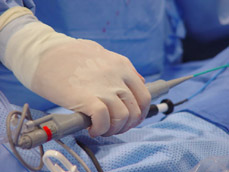
A new device, AVERT, has been found to significantly reduce the volume of radiographic dye without decreasing image quality in patients who are at risk of developing acute kidney injury (AKI) after undergoing a coronary angiography. Image source: www.cpmc.org
In the largest study of its kind, a new device has been found to significantly reduce the volume of radiographic dye without decreasing image quality in patients who are at risk of developing acute kidney injury (AKI) after undergoing a coronary angiography or percutaneous coronary intervention (PCI). The device—known as AVERT—did not, however, reduce contrast-induced AKI (CI-AKI). The AVERT results were presented as a late-breaking clinical trial at the Society for Cardiovascular Angiography and Interventions 2016 Scientific Sessions in Orlando.
CI-AKI is the sudden deterioration in renal function that can occur after the administration of radiographic dye—or contrast media volume (CMV)—during an interventional cardiac procedure. CI-AKI is associated with increased morbidity and mortality, and it affects an estimated 20 to 30% of patients, particularly those with diabetes or previous renal impairment. Minimizing CMV in patients at risk of AKI is a critical preventative measure.
With the AVERT system, or device, the operator can control the volume of dye used during an interventional procedure. Once the appropriate amount of dye has been injected into the coronary, the remaining dye goes into a reservoir, rather than into the aorta.
The prospective, randomized multi-center study enrolled 578 patients at 39 sites, who were considered to be at risk of CI-AKI while undergoing coronary angiography with or without PCI. The treatment group (n=292) included hydration and AVERT; the control group (n=286) received hydration only. The study’s objectives were to assess total CMV used and determine the incidence of CI-AKI, which was defined as a 0.3 mg/dl increase in serum creatinine within 72 hours post-procedure.
Of the 568 patients with CI-AKI, PCI was performed on 239 (42.2%). The use of AVERT resulted in a 15.5% relative reduction in CMV in all patients (86 ± 51 ml versus 101 ± 71 ml, p=0.002) and a 22.8% relative reduction in CMV for PCI patients (114 ml ± 55 versus 147 ± 81 ml, p=0.001). There were no significant differences in CI-AKI (27.0% versus 26.2%, p=0.72) or adverse event rates between the two groups.
Society for Cardiovascular Angiography and Interventions
www.scai.org




